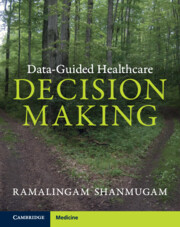Book contents
- Data-Guided Healthcare Decision-Making
- Data-Guided Healthcare Decision-Making
- Copyright page
- Dedication
- Contents
- Figures
- Tables
- About the Author
- Preface
- Glossary
- Notations and Symbols
- Prologue
- Introduction
- Chapter 1 Why and How Healthcare Decisions Are Made
- Chapter 2 Are Data-Guided Healthcare Decisions Superior?
- Chapter 3 Software
- Chapter 4 How to Collect Authentic Data
- Chapter 5 Uncertainties and Their Impact on Healthcare Decisions
- Chapter 6 Why Models Are Important in Healthcare
- Chapter 7 How Healthcare Decision Trees Emerge and Function
- Chapter 8 How Are Group Decisions Practiced in Healthcare?
- Chapter 9 Tracing and Remedying Root Causes of Adversities
- Chapter 10 Healthcare Decision-Making for Cost-Effectiveness
- Chapter 11 Risk Analysis in Healthcare Decision-Making
- Chapter 12 Evaluation of Healthcare Programs
- Chapter 13 Six Sigma and Lean Management in Healthcare Sectors
- Chapter 14 Forecasting in Healthcare Sectors
- Epilogue
- Appendix Statistical Tables
- Index
- References
Chapter 9 - Tracing and Remedying Root Causes of Adversities
Published online by Cambridge University Press: 13 July 2023
- Data-Guided Healthcare Decision-Making
- Data-Guided Healthcare Decision-Making
- Copyright page
- Dedication
- Contents
- Figures
- Tables
- About the Author
- Preface
- Glossary
- Notations and Symbols
- Prologue
- Introduction
- Chapter 1 Why and How Healthcare Decisions Are Made
- Chapter 2 Are Data-Guided Healthcare Decisions Superior?
- Chapter 3 Software
- Chapter 4 How to Collect Authentic Data
- Chapter 5 Uncertainties and Their Impact on Healthcare Decisions
- Chapter 6 Why Models Are Important in Healthcare
- Chapter 7 How Healthcare Decision Trees Emerge and Function
- Chapter 8 How Are Group Decisions Practiced in Healthcare?
- Chapter 9 Tracing and Remedying Root Causes of Adversities
- Chapter 10 Healthcare Decision-Making for Cost-Effectiveness
- Chapter 11 Risk Analysis in Healthcare Decision-Making
- Chapter 12 Evaluation of Healthcare Programs
- Chapter 13 Six Sigma and Lean Management in Healthcare Sectors
- Chapter 14 Forecasting in Healthcare Sectors
- Epilogue
- Appendix Statistical Tables
- Index
- References
Summary
Any adverse event is detrimental to patient welfare and to the reputations of the hospital/clinic, physicians’ or nurses’ licensing agency, and health insurance providers. All healthcare professionals desire to avoid adverse events. The chance for a recurrence of an adverse event could be lessened if health administrators learn from its first occurrence. For this purpose, health administrators perform what is termed root cause analysis (RCA). More often, RCA is done by interdisciplinary professionals and members of the patient community as an interactive team. There are three types of RCA – divergent, serial, or convergent. Which one among the three is medically or intuitively nontrivial? This chapter provides concepts, tools, and remedial plans to address non-repeatability. This knowledge springs from the collection of pertinent data for the selected adversity, an analytic approach to trace the causes, and setting up plans to ensure its nonoccurrence in the future.
- Type
- Chapter
- Information
- Data-Guided Healthcare Decision Making , pp. 212 - 243Publisher: Cambridge University PressPrint publication year: 2023



